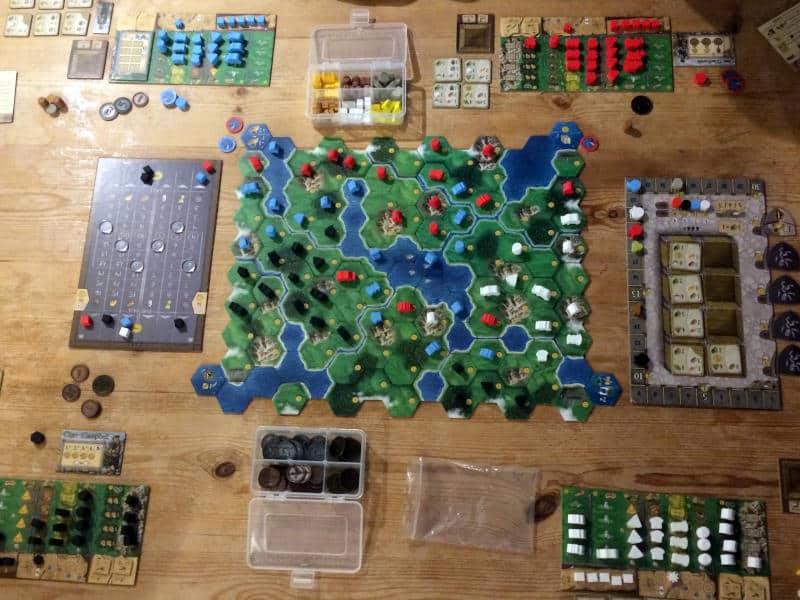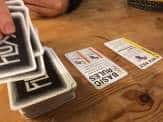I have always felt that the theme or setting of a game can really help with learning it. In a game about the Spice Routes, for example, it will be instinctively clear why there are mechanisms to exchange resources of different types with each other or for money. After all, that’s what the spice trade was mainly about. However, a game’s theme or setting isn’t necessarily useful. Sometimes it can be a hindrance. In this article, I want to look at this a bit more closely.
Listen to the Audio Version
Intro Music: Bomber (Sting) by Riot (https://www.
Music: Bensound.com/royalty-free-music
License code: QVNIZ5DQOGN5HCMX
Music by: Bensound.com/free-music-for-videos
License code: QXQZI3ILJMZNGIXX
Clans of Caledonia vs Terra Mystica
My favourite example of a game where the theme wonderfully supports the rules is Clans of Caledonia. At its core, it’s a game about placing tokens on hexes to produce goods. You fulfil contracts which require certain resources and you also want to control space on the board. On its own, that seems all very confusing, but when you add in the theme, things suddenly slot into place.
You place and then remove animal tokens, when you need to slaughter them for meat to fulfil your export contracts. You build cheeseries, distilleries and bakeries to convert your raw materials into refined goods that you give you profit. Area control is governed by the tributaries to the loch in the middle of the board. The theme brings it all together.
That’s not true for Terra Mystica, unfortunately. Now, while Clans of Caledonia is basically Terra Mystica set in 19th-century Scotland, the former’s setting really helps, while the latter’s makes things more confusing – at least for me. For example, I can just about explain why Terra Mystica‘s witches support four different cults. They could represent four different witch factions or ideologies or something like that. However, it makes no sense to me why they would terraform… sorry, transform terrain spaces. I’ve heard of witches turning princes into frogs, but not lovely meadows into swampland. And the witches are just one example that doesn’t make sense to me at all.
The setting of Terra Mystica is what really ruined my enjoyment of the game. In fact, it stopped me from getting into it for a very long time. It was only when I ignored the setting and saw it as a purely abstract game that I really got it. Now, I really love the game.

Expectation Mismatch
I think what these two examples show is that a player’s expectations are often highly influenced by a game’s theme or setting. If a game is about a certain topic or set in a certain location or time, even if these are completely fictitious, players will expect the game to “do” certain things.
That’s especially true for me. I’m a very visual person. To me, how a game looks makes a big difference to my gameplay experience. For the same reason, a game’s setting or theme matters to me. All of these elements ultimately influence whether I want to play a game or not. It also influences whether or not I buy a game.
So, if the expectations a game evokes aren’t met, then the game doesn’t only become confusing to play, but it can potentially put people off giving it a go in the first place, let alone buying a copy. While the saying goes that you shouldn’t judge a book by its cover, more often than not, we do exactly that.
That works both ways though. There are games I have bought because their first impression was positive on me. It’s why crowdfunding campaigns are still such a big thing. At the same time, I so often hear that how a game appeared on the crowdfunding campaign wasn’t borne out in real life. The expectations that the game set weren’t matched by how it actually played.
I don’t want to name names, but I have had a few games that I backed that disappointed. Those weren’t necessarily bad games, but they weren’t the games I had hoped for. They were games that did a good job of doing what they were designed to do, but in my head, they needed to be something bigger, better and more exciting.
Abstract Gamers
Of course, not everyone is influenced by theme, setting or looks. I know a few people who don’t give a thought to a game’s setting or theme, let alone to the illustrations or custom tokens. They only care about a game’s rules, mechanisms and how it functions. They look for the best way to score the most points. Whether that means that they’re placing cows onto the board and later removing them to send them to slaughter is of no, or at least very little, consequence to them. It’s just about the victory point potential.
Saying that, I do wonder how these people choose a game. I have the feeling that setting or theme does play a part in their decision-making. I doubt that they just read the rulebook to make up their minds about whether they want to play a game or not. I have the feeling that the setting or theme will have a bigger influence on them as they might make out. However, that’s just my speculation.

Target Audience
Either way, I do think it’s important for board games to seriously consider how they present themselves. It’s not necessarily straightforward to predict how players will see a game and what their expectations will be, especially when we’re talking about a wide variety of people with different experiences and backgrounds. It’s impossible for every game to appeal to everyone, but that doesn’t mean you can avoid considering a game’s target audience.
Having a strong theme or setting that is aimed at a small group of people can create a really good gameplay experience, but of course, commercially it’s quite risky. A more generic theme or setting will appeal to a wider audience and be more likely to be commercially successful, but at the same time, the gameplay experience can also be very bland.
How you find that balance, I don’t really know. I just know that a great game not only has a streamlined ruleset, evocative illustrations and practical and high-quality board game components, but it also meets players’ expectations perfectly. That’s where an established publisher can make a real difference, in my view. Spending time and money on playtesting shouldn’t be just about fixing rules or gameplay issues, but also establishing what players expect the game to be.
This blog is free for everyone, but if you'd like to support it, here are some options.
Useful Links
- Clans of Caledonia review: https://tabletopgamesblog.
com/ 2019/ 03/ 02/ clans-of-caledonia/ - Terra Mystica review: https://tabletopgamesblog.
com/ 2019/ 06/ 01/ terra-mystica/
Audio Version
Intro Music: Bomber (Sting) by Riot (https://www.
Music: Bensound.com/royalty-free-music
License code: QVNIZ5DQOGN5HCMX
Music by: Bensound.com/free-music-for-videos
License code: QXQZI3ILJMZNGIXX
Playlist
These are the songs I listened to while I was writing this topic discussion article:






